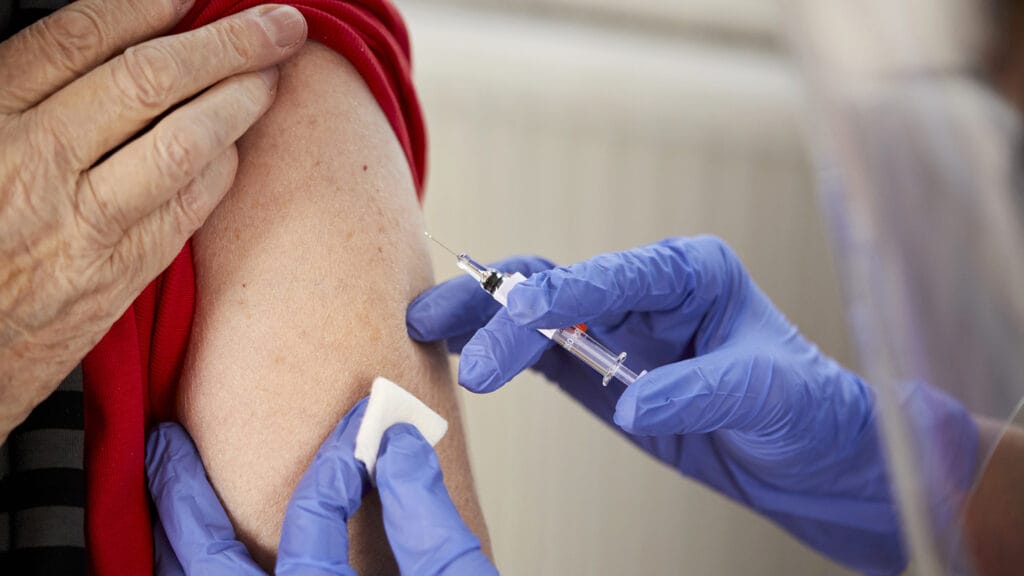
Increasing COVID-19, influenza and respiratory syncytial virus vaccination rates in older adults is going to require a village to battle vaccine reluctance in the form of misinformation, hesitancy and fatigue, according to senior living experts.
The Centers for Disease Control and Prevention recently released two reports on vaccination coverage and treatment for respiratory viruses. The agency found that vaccine fatigue, inaccurate health information and vaccine hesitancy contributed to lower vaccination rates in older adults.
A significant challenge is that many people now tend to equate COVID-19 with catching a cold, Argentum Vice President of Government Relations Paul Williams told McKnight’s Senior Living.
“We need to continue to emphasize how serious these respiratory viruses can be for our residents, who tend to have multiple comorbidities and chronic conditions, putting them at greater risk for serious complications, and even death,” Williams said. “At this point, so many people have made up their minds on vaccination, and trying to get folks to reconsider is an uphill task.”
Many people are “done with COVID” and any discussion of vaccines, he added.
“Vaccine fatigue is real, even though it remains a threat to the older adults we serve,” Williams said.
Raising vaccination rates
According to the CDC, uptake of the updated COVID-19 vaccine is approximately 37% in adults aged 75 or more years, compared with the national average of 19% among all adults. The statistics aren’t much better for the flu and RSV vaccines — only 34% of adults aged 65 or more years had received the flu vaccine as of Oct. 28 and only 17% of adults aged 60 or more years reported receiving an RSV vaccine as of Dec. 23.
Nursing homes have national reporting requirements for resident and staff member vaccination rates, making statistics more readily available than in assisted living, which does not have such requirements. And not all states are mandating or tracking vaccination in senior living community staff members for COVID, RSV or flu.
Williams said that Argentum is hearing that communities with strong leadership often have higher vaccination rates, and that staff members who trust and respect community leaders are more receptive to calls for vaccination and the importance of helping to protect residents and colleagues in the community.
“Communities that involve trusted nurses and clinicians to educate residents and answer questions on the risk and benefits of vaccines have higher rates,” he added. “The use of toolkits and talking points have proven to be helpful but the main barrier to increasing compliance remains ‘vaccine fatigue.’”
Challenges of vaccine reluctance
The challenge in battling vaccine reluctance is not unique to senior living or nursing home providers; it is systemic among the US population at large, according to the American Health Care Association / National Center for Assisted Living.
“As a country, we face significant challenges with vaccine reluctance that require a collective endeavor by public health officials, other healthcare providers and the public,” an AHCA/NCAL spokeswoman told McKnight’s Senior Living. “Assisted living providers remain persistent in talking to family members and residents about their vaccine concerns and appreciate the partnerships of the larger healthcare system to help reinforce the importance of the vaccines.”
Last week, US Department of Health and Human Services Secretary Xavier Becerra met virtually with representatives from LeadingAge and AHCA/NCAL to express concerns about low vaccination rates among residents of nursing homes, which are supported by federal dollars through the Medicare and Medicaid programs. LeadingAge said in a statement after that meeting that it had urged HHS to help ease logistical issues that have slowed vaccination rates and to encourage hospitals to offer vaccines on discharge.
David Gifford, MD, MPH, chief medical officer of AHCA/NCAL, writing in a column in McKnight’s Senior Living sister publication McKnight’s Long-Term Care News last week, discussed the need for the nation to collectively combat vaccine reluctance. He opined that strides in the right direction since the pandemic have been taken with vaccines, especially in the long-term care industry, but much collective work remains to be done by the healthcare profession to combat widespread hesitancy.
Vaccine fatigue and hesitancy, Gifford said, are “rampant,’ but especially so when it comes to COVID-19 and RSV vaccines. And although vaccine uptake in skilled nursing facilities is higher than in the general community (a number easier to know for nursing homes due to federal reporting requirements), he called for a doubling down on efforts to increase those numbers.
Gifford called for the ready availability of vaccines for residents through on-site vaccine clinics, provider reimbursements and consistent public health messaging. He said many new admissions arrive at an assisted living community or nursing home without being offered or having received the vaccine during visits with physicians in other healthcare settings.
AHCA/NCAL created a #GetVaccinated website last year with resources for providers to secure and administer vaccines on site, as well as resources to help encourage residents and staff members to receive vaccines.




